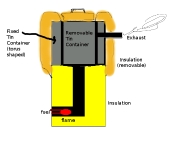Well, my plan was to do exactly as you suggested. Perlite and Fireclay slip, so that when the metal fails, the riser won't.
Been looking at also covering the outside with a blanket so that the riser cools more slowly to hopefully prefent (or reduce) thermal shock.
I built a small rocket stove prototype out of some fire bricks and was burning pellets with little trouble. As the OP pointed out, the feed mechanism is also somewhat fiddly. For my testing, I was just tossing a handful in periodically to get an idea of what kind of rate I would need. I discovered that too slow or too fast is death for the burn. It seems that there is a decent-sized window for rate, so coming up with a gravity-fed system should not be terribly difficult since ultra-precise regulation isn't needed.
As part of my other alternative heating explorations, I have been looking into burning waste oil. Specifically waste motor oil. It's usually quite plentiful. However, I was thinking to combine the wood pellet and oil burn into a single rocket stove. Most oil burners either use air flow to mist the oil into the burn chamber or they drip oil onto a steel plate that is in the burn chamber that gets so hot that no residue of the oil is left.
I thought of an alternative. Take some of the wood pellets and soak them in the oil until they are saturated. Some experimentation will be required to find the right ratio of oiled to non-oiled pellets, but it will allow me to get waste oil into the combustion chamber with nothing more than the gravity feed pellet system I want to use anyway. This also allows for easy switching between pure pellets and oiled/pure ratio mix or even pure oiled ones if that's doable.
I'd also like to design the gravity feed to be able to handle wood chips. Those are often readily available at certain times of year, or if someone is having a tree chipped, you could pull up in your truck with a shovel and offer to take the chips off their hands.
At any rate, I am still a newb to this, and have not het built a mass heater -- just a stacked brick (no mortar or sealant between them) rocket stove and I'm hooked. My understanding of thermodynamics (I'm no expert, but I've had some casual exposure) has given me lots of ideas on how to improve effeciency as well as design ways to burn alternate fuels. I'm doing this because my wife and I plan to move to the Texas desert and go off grid in the next couple years, and, there isn't an abundance of trees out there, let alone sticks. Since our coldest times will only dip into the 20s, we don't need a ton of heating capacity, but I could see us running the RMH to heat water or other tasks (perhaps heating oil to use in radiant baseboard heaters)
Right now, my attention has been drawn away from RMH to deal with another aspect of planning this move, but I'll circle back and once I have something that works (mostly) I'll post about it and solicit comment and suggestions for improvements.
Thanks!










